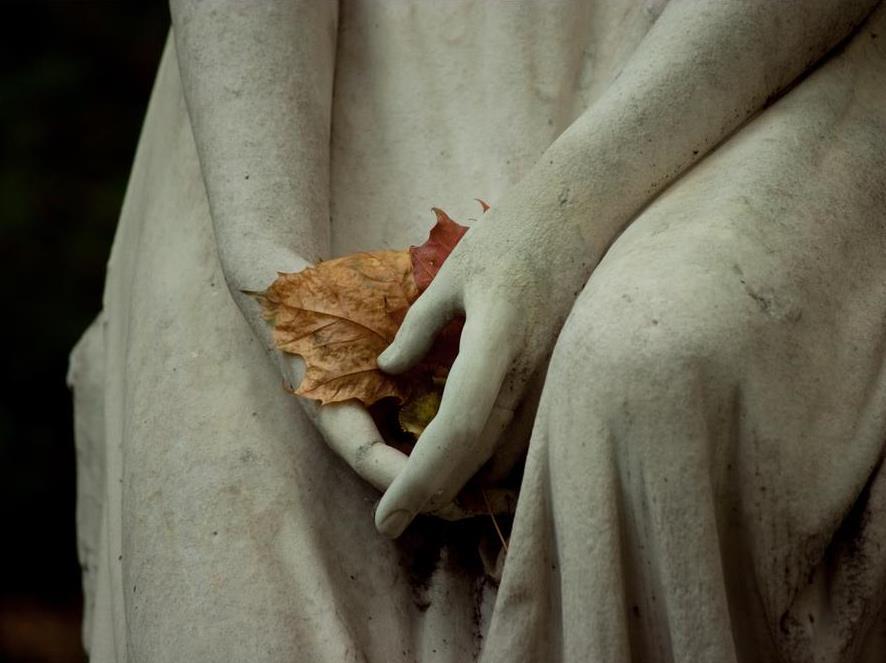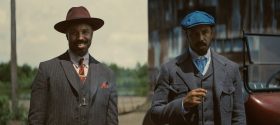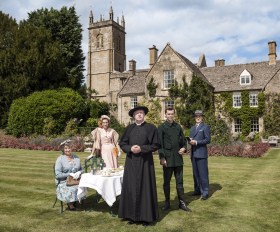Image via Shutterstock
2018 saw the deaths of many talented and inspiring people.
It was a year when we said goodbye to individuals who have had a remarkable impact on our world, from Winnie Mandela and Stephen Hawking to US Senator John McCain, who was known as “the maverick” for being unafraid to disagree. The world also mourned the loss of celebrities Kate Spade and Anthony Bourdain.
Among the creative souls we lost in 2018 internationally were the iconic Aretha Franklin, Pulitzer Prize winning author Neil Simon, legendary French composer and actor Charles Aznavour, writer Tom Wolfe, filmmaker Bernardo Bertolucci, the father of Marvel comics Stan Lee, actor Burt Reynolds, novelist and screenwriter William Goldman, and many more.
We salute them all.
VISUAL ARTS
Alun Leach-Jones (1937-2017)
Alan Leach-Jones sadly passed away on Christmas Eve (24 December 2017), missing our honours list for last year.
Born in Lancashire, UK, Leach-Jones spent the past half-century passionately devoted to his own language of abstraction, becoming recognised as one of Australia’s leading painters and printmakers in the genre. He presented more than 82 solo exhibitions from 1964, when he first started showing.
Read: Vale Alan Leach-Jones
Ron Tandberg (1944-2018)
Political cartoonist and illustrator Ron Tandberg died early January at the age of 74, after a battle with cancer.
Tandberg worked as a cartoonist for Melbourne newspaper The Age from 1972, and was known as the cartoonist who ‘stood for the little man’. The multiple Walkley Award-winning Fairfax Media cartoonist was last year inducted into the Melbourne Press Club’s inaugural Australian Media Hall of Fame, has been credited with reinventing the pocket cartoon, and won acclaim for his commentary on social and political issues.
His work has been recognised with 11 Walkley awards, including two Gold Walkleys, and he his graced the front pages of The Age and Sydney Morning Herald .
Daniel Kojta (1970 –2018)
Artist Daniel Kojta passed away 24 January. An interdisciplinary artist and curator based in the Blue Mountains, working in the arena of perception of phenomena, Kojta received the University medal with his Bachelor of Visual Arts (Honours), and completed his Master of Visual Arts Education, at the University of Western Sydney. He also completed his Diploma of Film Production at Sydney University and Australian Film Television and Radio School.
Kojta produced works that were often interactive or immersive installations. These works offered the audience an experience of phenomena often reflected in the natural environment.
Matthew Harding (1964 – 2018)
Melbourne sculptor Mathew Harding died 22 February, aged 53. A great Australian talent whose work touched so many people, he was renowned for public sculptures and leaves an extraordinary legacy of work across many of Australia’s cities and towns. Over a dozen of his public artworks bring life to the streets of Canberra alone.
Read: Vale Matthew Harding
Polixeni Papapetrou (1961- 2018)
After a prolonged battle with cancer, Melbourne photographer and artist Polixeni Papapetrou died 11 April, aged 57. Her work has featured in over 50 solo exhibitions, and over 100 group exhibitions internationally with major survey exhibitions at the Centre for Contemporary Photography, Melbourne (2013) and the Australian Centre for Photography, Sydney (2011).
Read: Vale Polixeni Papapetrou
Tate Adams (1922-2018)
Tate Adams passed away on 8 April at 96 years old. He was described by RMIT as the ‘grandfather of Australian printmaking’, and was a great pioneer also for Australian artists books.
He taught for 22 years at RMIT, from 1960-1981,where he established the first diploma of printmaking in Australia and encouraged a new generation of printmakers including George Baldessin, Hertha Kluge-Pott, Jock Clutterbuck, Graeme Peebles and Ros Atkins. During this time, he established Crossley Gallery, a dedicated print gallery that was arguably the leader in the promotion of prints in Australia.
Tate was named a Member (AM) of the Order of Australia for service to publishing and to the arts, particularly through contributions to the development of printmaking in Australia. A book on the artist, Tate Adams: In Black and White, is due for publication in 2018 by Thames and Hudson.
Robert Bell (1946-2018)
Dr Robert Stewart Bell AM died 28 July, after a prolonged battle with cancer. He was a giant in the Australian craft and design sector. Quick to advocate for local talent internationally, he was described as ‘an unfailingly generous and gracious man,’ who encouraged and supported artists working in the contemporary craft and design sector.
Bell was Senior Curator of Decorative Arts and Design (DAAD) at the National Gallery of Australia (NGA), Canberra from 2000 – 2016. He came to the gallery after 22 years in a similar position, as the inaugural Curator of Craft and Design at the Art Gallery of Western Australia (1978 – 2000). Prior to that, Bell was Senior Exhibits Designer with the Western Australian Museum (1967-1978).
Read: Vale Robert Bell
Charles Blackman (1928-2018)
Charles “Charlie” Blackman died just days after his 90th birthday on 12 August. Blackman was one of Australia’s most iconic painters of the post war era; the subject of weighty art tomes and a key voice in creating an Australian narrative.
In 1953 he was co-founder of the Melbourne Contemporary Art Society and in 1959 joined John Brack, Arthur Boyd, and Robert Dickerson to create The Antipodeans group.
In 1993 he was honoured with a retrospective exhibition, Charles Blackman: Schoolgirls and Angels, curated by Felicity St Moore for the National Gallery of Victoria. A portrait of Charles Blackman by Jon Molvig won the Archibald Prize in 1966. He was appointed an Officer of the British Empire (OBE) for services to Australian art in 1977.
He had dementia and had been looked after for years by a fleet of carers in his Sydney home.
Read: Vale Charles Blackman – Australia says goodbye to an Antipodean legend
Richard Giblett (1966-2018)
The visual arts sector was shocked by the premature death of Richard Giblett at just 51. He made artworks ‘using a range of methods that involve detailed model making to spray painted works on glass, meticulously hand painted large scale gouache paintings and collage on paper.’
Formerly from Western Australia, where he completed a Bachelor of Fine Arts (Honours) at Curtin University, Giblett moved to Melbourne 16 years ago. He exhibited regularly with Murray White Rooms in Melbourne and (previously) with Galerie Dusseldorf in Perth.
Mirka Mora (1928-2018)
Born in Paris, and migrating to Australia in 1951 with her husband Georges Mora (formerly a French resistance fighter whom she married in 1947) the Moras also became key figures in Melbourne’s emergent arts culture following their arrival. They befriended Sunday and John Reed, the founders of Heide Museum of Modern Art and Mirka Mora went on to become a vivacious champion of modernism. She died in September this year.
She was honoured with a State Funeral.
Read: Artist Mirka Mora dies aged 90
Donald Brook (1927-2018)
New of artist Donald Brook spread across social media during the Christmas break. He died just a few weeks short of his 92nd birthday. Described as ‘without doubt Australia’s greatest ever art critic and theoretician’. Donald Brook was born in 1927 in Leeds. An engineer and sculptor who emigrated to Australia in 1962, he taught at the Power Institute in the University of Sydney 1967-73, and was a provocative art critic. He was Professor of Visual Arts at Flinders University from 1974-89, and currently continues his prolific writing output from his office in a tower in an eco-friendly enclave in the centre of Adelaide.
PERFORMING ARTS
Erroll Buddle (1928-2018)
Saxophonist Errol Buddle, a prominent Australian jazz musician who developed an international reputation from the 1950s, died in March at the age of 89.
During this time he studied the bassoon at both Sydney and Adelaide Conservatoriums and after working in his home city and in Sydney in the ’40s, travelled to Canada in 1952 where he played first bassoon with the Windsor Symphony Orchestra.
He formed the Australian Jazz Quartet with a group with Australian musicians who were also living in Detroit, including Jack Brokensha and Bryce Rohde and this group eventually became a quintet. They signed up with the world’s top jazz agent, Joe Glaser in New York on a five-year contract and were booked into all the top jazz clubs in the US.
Buddle also worked extensively as a session musician for documentaries, movies and commercials over the next 30 years. He was arguably Australia’s most successful jazz export.
T.E. Lewis (1959-2018)
The Aboriginal actor, who starred in The Chant of Jimmie Blacksmith and The Shadow King, died in March in Katherine (NT), aged 59.
Lewis will be forever remembered for his compelling and enduring work on stage and screen over 40 years, as a renowned musician, and as the driving force and vision behind Djilpin Arts with his partner and his extended family of Beswick and Arnhem Land communities.
Read: Vale T.E. Lewis
Candy Royalle (1981-2018)
The award-winning poet, performer and activist died 23 June aged 37, after years of struggling with ovarian cancer.
She was described as ‘unflinchingly honest, a force of nature, eloquent, passionate and fiercely talented, storyteller, educator and activist’. A queer Lebanese-Palestinian Australian, she remained passionately committed to improving the profile of female artists of colour despite her illness.
Read: Vale Candy Royalle
Richard Gill (1941-2018)
Conductor and music educator Richard Gill AO, the inaugural dean of the West Australian Conservatorium of Music and founding director of Victorian Opera, died 28 October after a year-long battle with cancer. He was 76.
Remembered for his enthusiasm, energy, encyclopaedic knowledge of music and an unwavering belief that music was for everybody, Gill was memorably serenaded at his home in Stanmore, in Sydney’s inner west, by an impromptu orchestra the day before he died.
Read: Vale Richard Gill
Frank Ford (1935-2018)
Frank Ford AM, a pivotal figure in the development of two of South Australia’s most significant festivals, died in October this year after a short illness. He was 83.
Adelaide Fringe’s first Chair, Ford also founded the Adelaide Cabaret Festival, first held in May 2001 and established in response to the shifting nature of the Adelaide Fringe.
He was honoured with an Adelaide Cabaret Festival icon award in 2015, and remained a member of the Adelaide Cabaret Festival’s Advocacy Committee up until his death.
Read: Vale Frank Ford
Harry M Miller
Veteran Australian celebrity manager Harry M. Miller died in July at the age of 84. The manager, promoter and publicist represented a colourful and often controversial collection of public figures throughout his career, noted with bringing some of the biggest acts to Australia including The Rolling Stones and Beach Boy in the 1960s. He’s also credited with discovering a 16-year-old Marcia Hines in Boston, flying her to Australia to star in his production of Hair.
In 1992, Miller produced the national arena production of stage musical Jesus Christ Superstar. He retired in 2009 and in 2011 revealed he had been diagnosed with dementia.
Peter Smith 1931 – 2018
Holding an esteemed career in theatre since 1951, Peter Smith passed away 27 August aged 87. Smith started his career at the Independent Theatre in North Sydney, juggling a stage management role and acting for four years. It was a catalyst to taking on Stage Manager for the national tour of White Cargo, and other productions with The Old Vic Theatre Company. In the mid 1950s he moved to London working for Sadlers Well Opera running the lighting board, which was the start of his career as a lighting designer. He then returned to work as Stage Manager for the Old Vic theatre company and toured production extensivel, including the USA, Europe and even Russia.
1961 saw his return to Australia where he worked on the production of Oliver and touring various shows for JC Williamsons, and then joined the Elizabethan Theatre Trust and Alexander Theatre at Monash University as a Stage Manager. It was here he got the take for educating theatre practitioners. This led to training technical students at NIDA and was eventually appointed to their board of studies. He left for a short hiatus where he joined Strand Lighting under Reg Barton as their NSW Manager, but returned to NIDA for another seven years, where he started creating courses that became the foundation for his book “Duties of Stage Management” published by the West Australian Academy of Performing Arts (WAAPA).
In his later career, Smith moved to the Darling Downs Institute at Toowoomba to continue educating students, was Production Manager for the South Australian Opera Company, and was appointment at WAAPA returning to education. Wherever possible, he continued to take the opportunity of designing lighting notably for the Sydney Theatre Company and as resident designer for Rockdale Opera.
PUBLISHING
In January, author Meme McDonald died, aged 63. McDonald was the author of nine books for adults and younger readers, including The Binna Binna Man (A&U), which was co-written with Aboriginal storyteller Boori Monty Pryor and won three prizes, including Book of the Year at the NSW Premier’s Literary Awards in 2000.
McDonald was recipient of the 2012 AusCo Ros Bower Award for Community Arts and Cultural development.
Peter Corris (1942-2018)
Peter Corris, described as the godfather of Australian crime fiction, died peacefully in his sleep at the age of 76. A prolific writer, he was best known for his character Cliff Hardy, a private detective, and writing over writing 42 books over the course of a career that saw him recognised with the Lifetime Achievement Award from the Crime Writers Association of Australia, along with the 2009 Ned Kelly Award for Best Fiction.
Read: Vale Peter Corris
SCREEN
Nigel Dick (1928 – 2018)
Nigel Dick, a key media executive at the dawn of television in Australia, passed away peacefully on the morning of 8 March. In 1956, he became the first sales manager of GTV 9 in Melbourne. By 1960 he was the chief executive before taking over at TCN 9 in Sydney, a stepping stone to becoming a chairman of HSV 7 and Southern Cross Communications. Nigel was probably the last living executive to have worked with Sir Frank Packer, father to Clive and Kerry and grandfather of James. He later opposed, unsuccessfully, Kerry Packer’s push for the 1990s aggregation of regional licence.
Read: Nigel Dick – death of a civilised supremo
Tony Morphett (1938-2018)
Tony Morphett was a giant of television drama since the early years, who never stopped writing and remained in favour until he was into his mid-seventies. Morphett died of a heart attack on 18 June, aged 80.
Read: Tony Morphett: ‘You wanted to be worthy of his respect’
CRITICS, CONSULTANTS AND PATRONS
Wal Eastman (1928-2018)
Described by those who knew him as ‘one of nature’s real gentlemen’, ‘unfailingly kind,’ ‘humane and remarkably wonderful,’ and ‘a stalwart of Hobart’s theatre scene,’ Walter ‘Wal’ Eastman OAM passed away on Tuesday 9 January. He was 89.
A passionate supporter of Hobart’s theatre sector, Eastman worked for over 20 years as theatre critic for the city’s daily newspaper, The Mercury. He also contributed theatre reviews with Ric Patterson on ABC Radio. Since 2003, Eastman served as patron of the Fellowship of Australian Writers Tasmania, becoming a life member of the organisation in 2007. His services to the Tasmanian arts sector and the broader community were acknowledged in 2010 with an Order of Australia medal.
Read: Tasmanians mourn death of arts identity Wal Eastman
Michael Hobbs (1934 -2018)
The Sydney art world began the year in mourning with the news that collector and patron Michael (Joseph) Hobbs OAM passed away suddenly at home on 1 February, just a week shy of his 84th birthday.
While always engaged, always curious, and always up for a conversation, it was Michael Hobbs’ love of life and art that left an incredible legacy for the Australian art world.
In 2017 Hobbs received an Order of Australia in recognition of his service to the visual arts.
Read: Vale Michael Hobbs
Virginia Wilson (1966-2018)
Virginia Wilson was a Sydney based art consultant, art adviser and broker, who worked with artists, business and government; she also helped devise site-specific works for new building projects and corporate collections. Wilson drew her formidable knowledge of art and the business of art from her time working in commercial galleries and auction houses, before starting Virginia Wilson Art.
Wilson died after a battle with cancer. She was just 52. Andrew Frost said: ‘Virginia had a great eye for art, and a nose for art world bullshit … Born and raised in the central western NSW town of Forbes, she combined an earthy, country attitude and straightforwardness with a sophisticated world view that, to me, seemed the epitome of a genuine and caring nature.’





